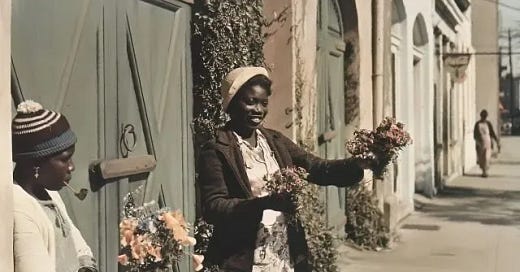Rooted Vernacular Studio
Mission of Intent
FEB 01, 2024
Rooted Vernacular Studio creates art grounded in the process of gathering beauty to make a beautiful & bountiful life that we call Assemblage.
Rooted Vernacular Studio is an extension of putting my Assemblage theory into Praxis. Rooted Vernauclar is an extended arm of my creative practice & offerings. The conclusion of my senior thesis found that there is a vacuum of critical language to discuss Black subjectivity because it is rooted in the vernacular. The vernacular is the found, gathered, intuitive artful making of a life…otherwise known as an assemblage. To explore more of the theory of Assemblage this studio is rooted in explore Assemblage: Baby's Breath (more specifically click here & here).
Some examples of a vernacular practice include quilting, gathering ingredients to make a meal, gathering clay to make vessels, & gardening. An important tenant of the assemblage theory is the vernacular practice/right to gather & share beauty. I am reminded of one of Toni Morrison’s responses to Claudia Brodsky Lacour in a 1992 interview conducted in her Princeton office. Morrison says:
“I think of beauty as an absolute necessity. I don’t think it’s a privilege or an indulgence, it’s not even a quest. I think it’s almost like knowledge, which is to say, it’s what we were born for.”
I would also argue that beauty is not a quest because it is embodied. This is an important assertion to make because the label “vernacular” is typically used to describe anyone who is self-taught. Especially, Black Southerners who have been guided by themselves in honing their craft. In other words, these architects of their lives didn’t go to culinary school, art school, or earn a creative writing MFA. Their embodied knowledge of beauty propelled them toward & into their “vernacular” practice. As a Black Southern Woman, these terms have historically been used to discard Southerners & the South as a region. However, I have found that vernacular practices are an essential part of sustaining myself, the land, & community.
Saidiya Hartman writes that “beauty is not a luxury, rather it is a way of creating possibility in the space of enclosure, a radical act of subsistence, an embrace of our terribleness, a transfiguration of the given. It is a will to adorn a proclivity for the baroque, & the love of too much.” That is to say that there are complex details of beauty that have adorned Black folk’s dwelling spaces for generations. These dwelling spaces for Black folk include the body, the home, & rich interior lives. Thus resulting in a generation of beauty in the loophole that leads to infinite possibilities (always starting with the body first).
Saidiya‘s use of language, “a radical act of subsistence,” lends itself to the first measure of the song that is Rooted Vernacular Studio. According to Kaia Niambi Shivers, the floral industry bloomed out of Black women's growing avenues of economic stability after emancipation.” Newly freed Black women created their own loophole to escape the domestic work that made them vulnerable to abuse through the selling of flowers. Abra Lee, a renowned Black Woman Horticulturist, lovingly refers to these women as legendary flower sellers. The legendary flower sellers flourished along the eastern coast of the United States in places like Washington D.C., Richmond, Virginia, & on Broad & King Street in Charleston, South Carolina. I remember taking trips to Charleston every summer growing up. I was always in awe of seeing artists making palmetto roses & admiring the floral beauty by the sea. In these locations, Black women participated in the radical act of subsistence by selling flowers & herbs.
While we often hear of Black folk forcibly working the land, working it for subsistence, there is also a long-standing history of Black folk tending to the soil for the sake of Beauty. Black folk tended to the soil & planted flowers because of the grief of feeling “the love of too much.” Whether it was through the separation of family due to chattel slavery, longing for an ancestral home they will never see, or the physical loss of the life of loved ones…the flowers bloomed. At a time when Black folks had no proper burial & no headstones, flowers, shells, & herbs were placed in burial sites. It was also common to remember the site of the love of too much by the feel of the land & surrounding plant life.
Toni Cade Bambara writes on page 152 of The Salt Eaters…
“And let her soul get on with it’s gathering and return with greater force to its usual place.”
“To go gathering, the feel of the basket handle on her arm. To talk with the lemon grass, enlist the cooperation of eucalyptus. They didn’t mind her, did not resist her. Always came up easily in her grip. Eyebright in the underbush calling. Bladderwort singing. Calamus around the salt marshes.”
This is the language that serves as further evidence of the importance of being rooted in the vernacular ways of life that assert Black folk as subjects. This studio, & measure one: floral arrangements, is conjured with the intention to make Black folk feel seen & valued. While we are starting with blooms, the theory of assemblage & vernacular art is very expansive. Rooted Vernacular Studio is a container for, however “the love of too much” materialized in the world. Rooted Vernacular continues the traditions of Black women financially supporting ourselves through the embodied gathering, sharing, & assemblage making as a Southern Black Woman-owned business. To pull from the lineage of June Jordan who planned to…
“blossom bloody on an afternoon surrounded by my comrade singing terrible revenge in merciless accelerating rhythms” — I Must Become a Menace to My Enemies
These are bloody blooms that are actively creating an artful life that we call Assemblage.




